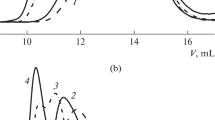Abstract
To gain insight into the mechanism treating formation of hyperbranched polylysines through the polymerization of N ɛ-carbobenzoxylysine N-carboxyanhydride under conditions of the reductive removal of a N ɛ-carbobenzoxy group, hyperbranched polylysine has been synthesized with the use of trifluoroacetic acid as a terminator in the polymerization of N-carboxyanhydride. The structure of the polymers is studied by capillary electrophoresis, low-pressure gel-permeation chromatography, circular dichroism, and enzymatic hydrolysis with trypsin. At the first stage of synthesis, a low-molecular-mass strongly branched core of the polymer is formed. At the second stage, polylysine chains are grafted via one point onto amino groups of N-terminal lysine moieties of the low-molecular-mass core through their carboxyl ends.
Similar content being viewed by others
References
G. T. Hermanson, Bioconjugate Techniques (Academic, New York, 1996).
Vector Targeting for Theraupeutic Gene Delivery, Ed. by D. T. Curiel and J. T. Douglas (Wiley-Liss, Hoboken, 2002).
J. F. Kukowska-Latallo, A. U. Bielinska, J. Johnson, et al., Proc. Natl. Acad. Sci. U. S. A. 93, 4897 (1996).
W. Tansey, S. Ke, X.-Y. Cao, et al., J. Controlled Release 94, 39 (2004).
M. Ohsaki, T. Okuda, A. Wada, et al., Bioconjug. Chem. 13, 510 (2002).
T. Okuda, S. Kidoaki, M. Ohsaki, et al., Org. Biomol. Chem. 1, 1270 (2003).
G. P. Vlasov, V. I. Korol’kov, G. A. Pankova, et al., Bioorg. Khim. 30, 1 (2004).
T. Okuda, A. Sugiyama, T. Niidome, and H. Aoyagi, Biomaterials 25, 537 (2004).
G. P. Vlasov, V. I. Korol’kov, I. A. Gur’yanov, et al., Bioorg. Khim. 31, 167 (2005).
G. P. Vlasov, Bioorg. Khim. 32, 227 (2006).
H. Polland, J.-S. Remy, G. Loussouarn, and S. Demolombe, Biol. Chem. 273, 7507 (1998).
A. Boletta, A. Benigni, J. Lutz, et al., Hum. Gene Ther. 8, 1243 (1997).
H. Faneca, S. Simoes, and M. C. Pedroso De Lima, Biochem. Biophys. Acta 1567, 23 (2002).
J. P. Behr, B. Deminea, J. P. Loeffler, and J. Perez-Mutul, Proc. Natl. Acad. Sci. U. S. A. 86, 6982 (1989).
G. P. Vlasov, G. M. Pavlov, N. V. Bayanova, et al., Dokl. Akad. Nauk 399, 366 (2004).
I. Tsogas, T. Theodossiou, Z. Sideratuo, et al., Biomacromolecules 8, 3263 (2007).
G. P. Vlasov, I. I. Tarasenko, S. V. Valueva, et al., Polymer Science, Ser. A 47, 422 (2005) [Vysokomol. Soedin., Ser. A 47, 731 (2005)].
G. P. Vlasov, A. P. Filippov, I. I. Tarasenko, et al., Polymer Science, Ser. A 50, 374 (2008) [Vysokomol. Soedin., Ser. A 50, 589 (2008)].
W. Daly and D. Poche, Tetrahedron Lett. 29, 5859 (1988).
G. P. Vlasov, G. D. Rudkovskaya, L. A. Ovsyannikova, et al., Vysokomol. Soedin., Ser. B 25, 176 (1983).
G. P. Vlasov, G. D. Rudkovskaya, L. A. Ovsyannikova, et al., Vysokomol. Soedin., Ser. B 28, 439 (1986).
G. R. Newkome, C. N. Moorefield, and F. Vogtle, Dendritic Molecules (Concepts, Synthesis, Perspectives) (VCH, Weinheim, 1996).
E. V. Anufrieva, M. G. Krakovyak, T. D. Anan’eva, et al., Polymer Science, Ser. A 49, 671 (2007) [Vysokomol. Soedin., Ser. A 49, 1013 (2007)].
Author information
Authors and Affiliations
Corresponding author
Additional information
Original Russian Text © G.P. Vlasov, I.I. Tarasenko, G.A. Pankova, I.E. Il’ina, V.I. Vorob’ev, 2009, published in Vysokomolekulyarnye Soedineniya, Ser. B, 2009, Vol. 51, No. 8, pp. 1559–1566.
This work was supported by the Russian Foundation for Basic Research, project nos. 04-03-33032 and 07-03-00290.
Rights and permissions
About this article
Cite this article
Vlasov, G.P., Tarasenko, I.I., Pankova, G.A. et al. Hyperbranched polylysines: Mechanism of formation. Polym. Sci. Ser. B 51, 296–302 (2009). https://doi.org/10.1134/S1560090409070136
Received:
Revised:
Published:
Issue Date:
DOI: https://doi.org/10.1134/S1560090409070136




